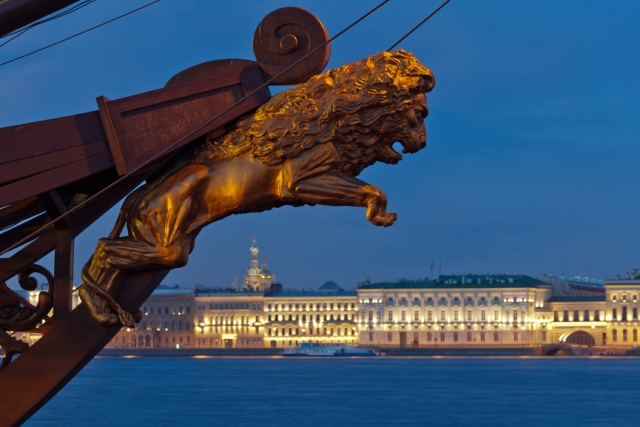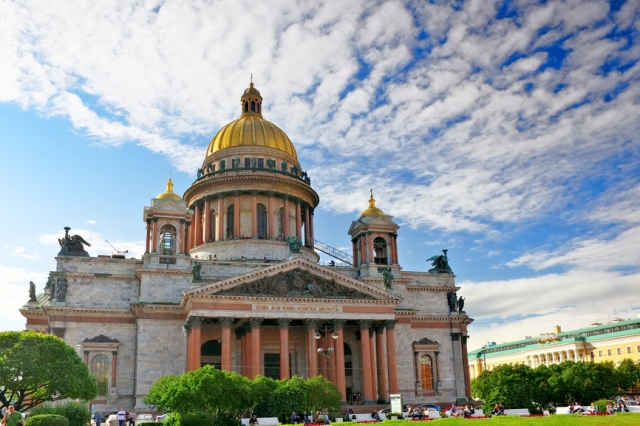St. Petersburg Puts its Hopes in Transit Air Passengers
.jpg)
St. Petersburg hopes that 72-hour visa-free rule for air passengers, which now also covers cruise and ferry tourists, will help attract foreign tourists to the city. According to the city’s governor Georgy Poltavchenko, the State Duma may pass the necessary amendments as soon as this May.
St. Petersburg has a chance of getting support in its fight for the foreign tourist as soon as this year. It is possible that the law on 72-hour visa-free regime upon entering Russia for air passengers will be passed as soon as this May. This way, St. Petersburg will be able to add air transit passengers to the already existing ferry transit visitors.
The initiative came straight from the head of the city. “At the end of last year I submitted a proposal to the State Duma which suggested that not only passengers of sea cruise liners should be able to stay in Russia for 72 hours without visa, but plane passengers as well. Since then, the law has been improved and received the majority of the necessary approvals, and there is hope that it will be passed as soon as this May,” said St. Petersburg’s Governor Georgy Poltavchenko during his yearly report on the government’s activities during 2013.
According to Poltavchenko, this measure will increase the number of foreign arrivals to St. Petersburg, which will be facilitated by the fact that the capacity of Pulkovo’s new terminal is 17 million people a year. He then added that neither western sanctions, nor political scheming will undermine foreigners’ interest in the city. “Despite all kinds of lies about our laws, the tourist flow did not decrease in 2013,” he said.
He was speaking about the so-called law that banned gay propaganda in St. Petersburg, which was passed in spring last year. This law triggered criticism of the city from Europe and the US, particularly from a number of western media personalities and movie stars.

Poltavchenko underscored that, according to last year’s results, St. Petersburg for the first time ranked among the best travel destinations of Europe. The industry of arrivals was growing at a faster rate than the industry of staying in the city. In this regard Poltavchenko ordered a revision of all the previous experience in developing hotel chains. “The city needs special measures that would catalyze the construction of new hotels,” he said.
As of today, there are 80 hotels in St. Petersburg with 16 thousand rooms. There are 15 international tour operators working in the city, which manage about half of all these rooms. The remaining 50% are made up of small hotels, 1-2 star accommodation, hostels and flats. The average occupancy rate of St. Petersburg’s hotels during June of the summer season reaches 95%, and during the summer-winter season the rates drop below the mean European levels and only reach about 45%.
According to Poltavchenko, last year St. Petersburg’s hotels and restaurants paid 30% more in taxes than the year before. He says that this is indicative not only of the development of the segment, but also of the demand it enjoys among the city’s visitors.
Another fast-growing segment of St. Petersburg’s inbound tourist flow is yacht tourism. Formally, St. Petersburg has every chance to compete for yacht tourists with other Baltic ports, but it still lags behind other cities in terms of quality and quantity of its infrastructure.

“The crossing point that was opened last year in Konstantin fort reduced the procedure of crossing the border by small vessels, sailboats and pleasure crafts to half an hour. However, we need to have more yacht moorings – 6-10 thousand, as opposed to 300 that we have right now,” said Poltavchenko.
Today, for 16 thousand regularly used small boats the city has no more than 50 quays with the total capacity of 6 thousand boats, with only 1.2 thousand moorings being allotted for visiting yachts.
According to an estimate of Federation Council Member Vadim Tyulpanov, development of the yacht tourism can increase the city’s profits by 250 million euro a year.
Finally, Poltavchenko said that, in order to develop the tourism sphere and make St. Petersburg more attractive to visitors, the city will be developing modern Internet technologies and increasing the number of tourist itineraries. For instance, last year 12 new museums were opened, as well as 45 new tourist itineraries; a functional purpose concept and drafts of architectural and artistic decorations of the territory were prepared for Apraksin Yard.
As for the Internet, by the end of the year free Wi-Fi networks are planned to be installed in 20 of the more visited historical and cultural objects of St. Petersburg. However, Poltavchenko did not specify the exact locations where these networks will be set up. According to TRN’s own sources, currently free Wi-Fi in St. Petersburg can be found in Nevsky Avenue (from Palace Square to Vosstaniya Square), in the area of the Peter and Paul Fortress, as well as in the Summer and Tauride Gardens, 300 Years St. Petersburg's Anniversary Park, Maritime Victory Park, Kirov Central Culture and Leisure Park, and at 40 stations of St. Petersburg’s underground.
In their comments on Poltavchenko’s report, inbound tourism tour operators seemed to support the governor’s position. However, main requests to the city authorities remain the same as before: better promotion of the city on the foreign markets, sorting out the issues with tourist bus parking, and organizing large events during the off-season. The latter, by the way, will soon come to fruition: for the first time in many years, St. Petersburg International Economic Forum, the main business event for the city, will be held sooner than the peak of the White Nights: during May 22-24.


.jpg)
.jpg)
.jpg)
.jpg)